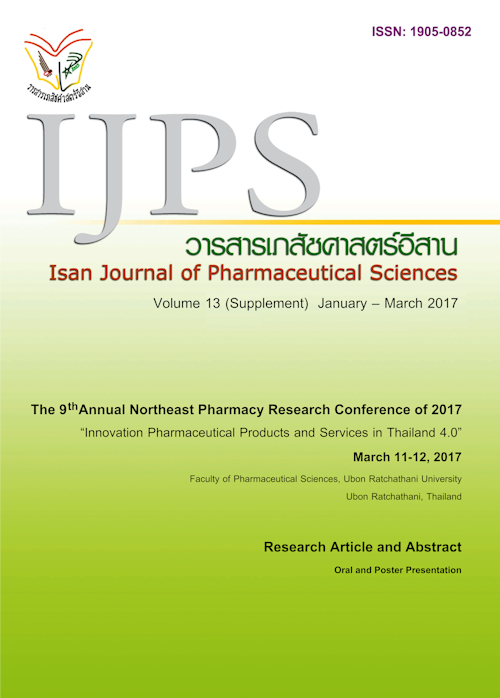Comparative study on binding capacity of some natural binders using paracetamol tablet produced by wet granulation method as a model
Main Article Content
Abstract
Introduction: Natural polysaccharides can be utilized as pharmaceutical binder. The purpose of the present study is to evaluate the binding capacity of some natural polysaccharides, i.e., pregelatinized starch, glutinous rice starch and pectin, for providing the basic information of tablets production in the pharmaceutical industry. Methods: These natural polysaccharide binders were utilized in preparing paracetamol tablets with wet granulation method. Tablet quality control tests, i.e., hardness, friability, disintegration time and dissolution, were examined for evaluating the binding capacity of binder. Results: The increases of hardness and disintegration time and the decrease of friability were correlated with the higher amount of binder. Glutinous rice starch showed the highest binding capacity followed by pectin and pregelatinized starch, respectively. The study of drug dissolution test demonstrated that type and amount of binder played an important role on the drug release rate. Increasing the amount of binder could diminish the drug release rate. In addition, paracetamol tablets prepared by the wet granulation method using glutinous rice starch as a binder showed the slowest rate of drug release. Conclusion: Glutinous rice starch and pectin exhibited good binding capacity. Type and amount of binder could be optimized and designed for tablet formulation development to obtain the desired drug release pattern.
Article Details
In the case that some parts are used by others The author must Confirm that obtaining permission to use some of the original authors. And must attach evidence That the permission has been included
References
Awen BZ, Chandu BR, Katakam P, Dasari V, Peraman R. Exploitation of gum olibanum as novel natural binding agent in the desigining of oral furosemide formulation. J Chem Pharma Sci 2010; 3: 71-74.
Berthoumieu D, Trannoy P, Cordolian JF, et al. Tabletting study for oral disintegrating tablets. Manufacturing chemist 2010; 24-27.
British Pharmacopoeia Commission, 2013, British Pharmacopoeia 2013 volume I-IV, the Stationery Office, London.
Désévaux, C, Dubreuil P, Lenaerts V, Girard C. Tissue reaction and biodegradation of implanted cross-linked high amylose starch in rats. J Biomed Mater Res 2002; 63: 772-779.
Enauyatifard R, Azadbakht M, Fadakar Y. Assessment of ferula gummosa gum as a binding agent in tablet formulations. Acta Pol Pharm Drug Research 2012; 69(2): 291-298.
Khule NR, Mahale NB, Sheler DS, et al. Extraction of pectin from citrus fruit peel and use as natural binder in paracetamol tablet. Scholars research libraly 2012; 4(2): 558-564.
Menon SS, Basavaraj BV, Bharath S, Deveswaran R, Madhavan V. Formulation and evaluation of ibuprofen tablets using orange peel pectin as binding agent. Der Pharmacia Lettre 2011; 3(4): 241-247.
Peerapattana J, Phuvarit P, Srijesdaruk V, Preechagoon D, Tattawasart A. Pregelatinized glutinous rice starch as a sustained release agent for tablet preparations. Carbohydr Polym 2010; 80(2): 453j459.
Rahim H, Khan MA, Badshah A, Chishti KA, Khan S, Junaid M. Evaluation of Prunus domestica gum as a novel tablet binder. Braz J Pharm Sci 2014; 50(1): 195-202.
Rahman BM, Ibne-Wahed MI, Khondkar P, et al. Effect of starch 1500 as a binder and disintegrant in lamivudine tablets prepared by high shear wet granulation. Pak J Pharm Sci 2008; 21(4): 455-459.
Rajak P, Nath IK, Bhuyan B. Application of assam bora rice starch as a binder in formulation of Paracetamol tablets. Int J Pharm Pharm Sci 2014; 6(5): 118-120.
Shailendra P, Shikha A, Singh LB. Natural binding agents in tablet formulation. Int J pharm biol sci arch 2012; 3(3): 466-473.
Shamsuddin SK, Suria J, Kamrul HC, Lucky A. Evaluation of anti-moisture effect of HPMC, Kollidon CL and Aerosil-200 in hydrolysis affinity clopidogrel-aspirin tablet using delta t moisture sensor. Int J of Adv in Pharm 2013; 2(2): 17-24.
Srivastava P, Malviya R, Kulkarni GT. Formulation and evaluation of paracetamol tablets to assess binding property of orange peel pectin. Int J Pharm Sci Rev Res 2010; 3(1): 30-34.
United States Pharmacopeia (USP) 36 and The national formulary (NF) 31, Asian edition. Rockville: USP Convention Inc; 2013. Vilivalam, VD, Illum L, Iqbal K. Starch capsules: an alternative system for oral drug delivery. Pharm Sci Technol Today 2000; 3: 64-69.


